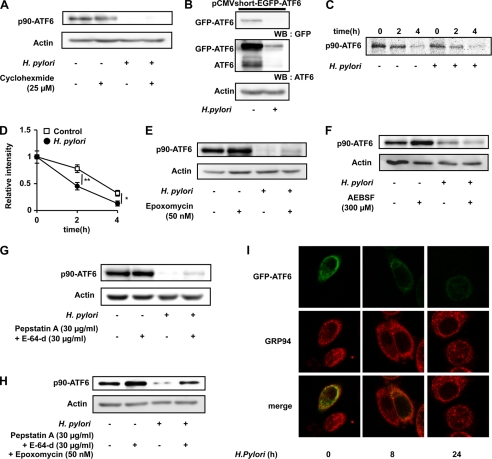FIGURE 4.
Mechanism for the H. pylori-dependent decrease in the level of ATF6. A and E–H, AGS cells were pre-incubated with or without each drug for 1 h and further incubated with or without H. pylori at a bacteria:cell ratio of 200:1 for 24 h in the presence (E, G, and H) or absence (A and F) of the same concentration of each drug as in the preincubation step. B and I, AGS cells were transfected with pCMVshort-EGFP-ATF6α (42) and co-cultured with or without H. pylori at a bacteria:cell ratio of 200:1 for 24 h (B) or indicated periods (I). A, B, and E–H, whole cell extracts were analyzed by immunoblotting (WB) with an antibody against GFP, ATF6, or actin. C, AGS cells were pulse-labeled for 30 min with [35S]methionine and [35S]cysteine and then chased with excess amounts of cold methionine and cysteine for the indicated periods in the absence or presence of H. pylori at a bacteria:cell ratio of 200:1. Labeled proteins were extracted, immunoprecipitated with antibody against ATF6, subjected to SDS-PAGE, and autoradiographed. D, the band intensity of p90-ATF6 was determined and expressed relative to the control. I, cells were fixed, stained with antibody against GRP94, and analyzed by confocal laser-scanning fluorescence microscope (magnification, 600 times). Values are the mean ± S.D. (n = 3). **, p < 0.01; *, p < 0.05. AEBSF, 4-(2-aminoethyl)benzenesulfonyl fluoride.

